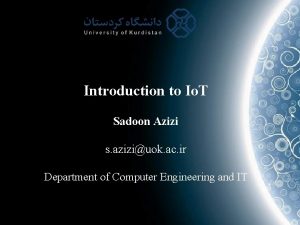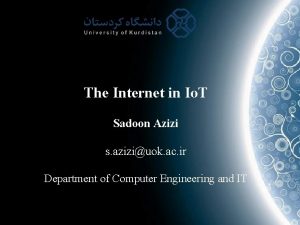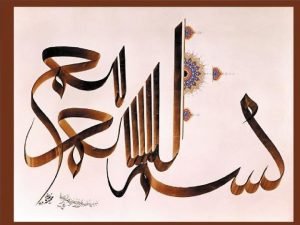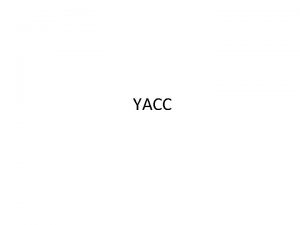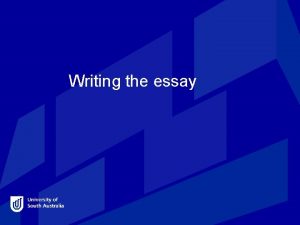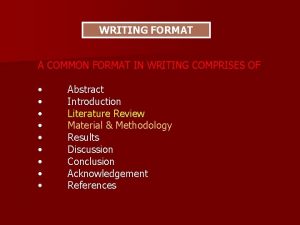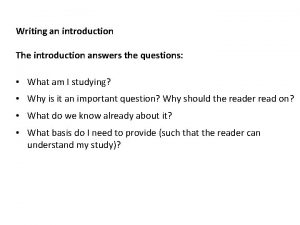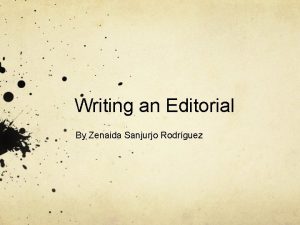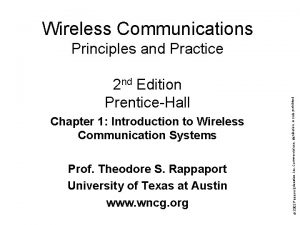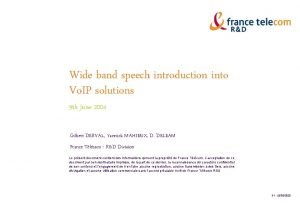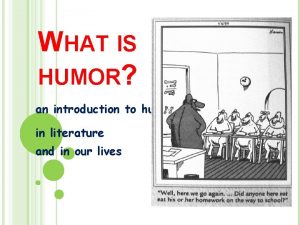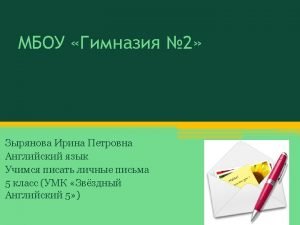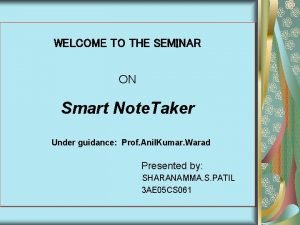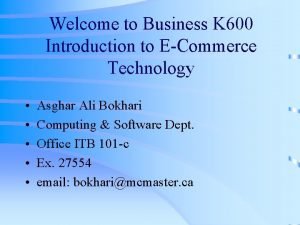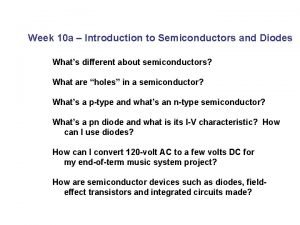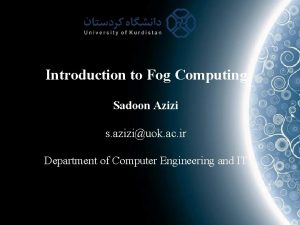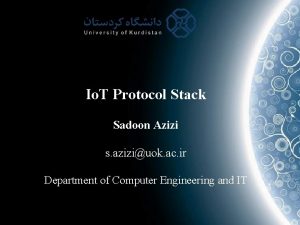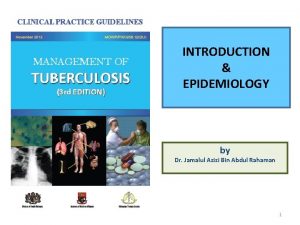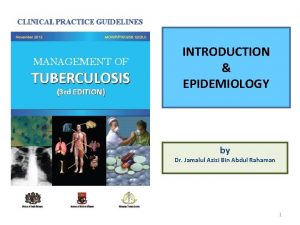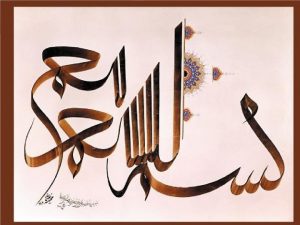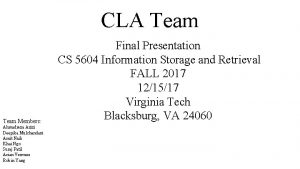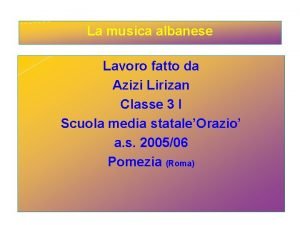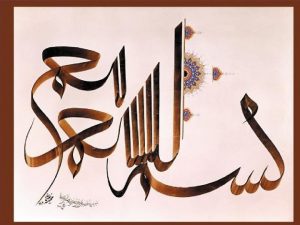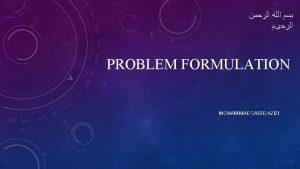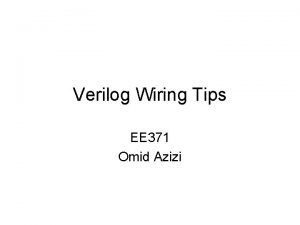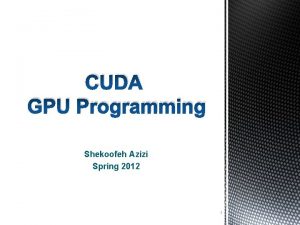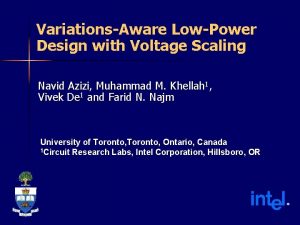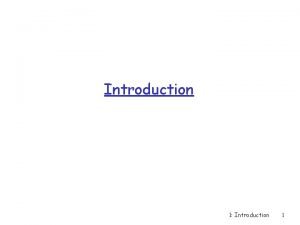Introduction to Io T Sadoon Azizi s aziziuok































- Slides: 31

Introduction to Io. T Sadoon Azizi s. azizi@uok. ac. ir Department of Computer Engineering and IT

Chapter Objectives * In this chapter students must learn: q The Concept of Internet of Things q Internet of Things’ definition q Internet of Things’ architecture q Some practical usecases q Io. T’s use in Universities, Research centers, Industry and Business. 2

The Concept of Internet of Things There are two fundamental pieces that make up the concept: q Things: Including a set of end devices with abilities like Sensing the environment (using the sensors), Computing intelligence (microcontrollers and electronic boards) and Network connectivity (mostly wireless technologies). § Note: a thing (object) might perform an action on the environment (using the actuators) instead of sensing it. q Internet: The traditional internet infrastructure. 3

The Concept of Io. T: Sensing the environment Light sensor Temperature sensor Blood pressure sensor Air pollution sensor 4

The Concept of Io. T: Computing intelligence Arduino UNO Raspberry Pi 3 Model B Arduino NANO Raspberry Pi Zero 5

The Concept of Io. T: Network Connectivity 6

Intelligent Refrigrator 7

The ultimate goal of Io. T q The ultimate purpose of Io. T is that all things around us will be able to sense the environment and through the connectivity among themselves and with us provide a better environment. q Examples: § Remote plants irrigation § Automatic light adjustment § Intelligent parking § Taking care of the elderly § Water management for agricultural use §. . . 8

What is Internet of Things? v There are various definitions for Internet of Things: q Wikipedia q International Telecommunication Union - ITU q Course’s reference book 9

What is Io. T? (Wikipeida) Ø The Internet of things (Io. T) is the network of physical devices, vehicles, home appliances and other items embedded with electronics, software, sensors, actuators, and network connectivity which enables these objects to connect and exchange data. Ø Each thing is uniquely identifiable through its embedded computing system but is able to inter-operate within the existing Internet infrastructure. 10

What is Io. T? (ITU) Ø ITU-T Y. 2060 (06/2012) Ø A global infrastructure for the information society, enabling advanced services by interconnecting (physical and virtual) things based on existing and evolving interoperable information and communication technologies. q NOTE – Through the exploitation of identification, data capture, processing and communication capabilities, the Io. T makes full use of things to offer services to all kinds of applications, whilst ensuring that security and privacy requirements are fulfilled. 11

What is Io. T? (reference book) q Internet of Things can be considered a network of physical resources that are powered by: Sensors: to collect information § IDs: to authorize the data source § Software: to analyze the data § Internet connectivity: for collaboration and notification § Gathering all these: Ø Io. T is the network of things, with clear element identification, embedded with software intelligence, sensors, and ubiquitous connectivity to the Internet. 12

What is Io. T? (reference book) * Things can be anything: Sensors, devices, machines, people, animals, trees, etc. 13

A better definition (reference book) * Data transmission according to the standards that guarantee the collaboration and enable useful procedures (mostly automatic). 14

A better definition (reference book) Internet of Things Internet of People Internet of Everything (Io. E) A more generalized definition of Io. T: Ø Io. T is the network of things, with device identification, embedded with software intelligence, and sensing and acting capabilities, connecting people and things over the Internet. 15

Introduction history of Io. T: q The Concept of Io. T was first used by Kevin Ashton in 1999. He described a universe in which, everything (including inanimate objects) has a digital identity so that they can be managed by computers. q “Internet of Things has the potential to change the world, just as the internet did. Maybe even more so. ” Said Kevin Ashton q MIT Auto-ID Center presented viewpoint about the Io. T in 2001. q Finally, Internet of Things was officially introduced by ITU in 2005. their 16

Fundamental requirements for an Io. T-based solution. 17

Why do we want to manage and supervise things? q Object management for specialists (blood pressure and heartbeat control) q Searching for Things (Where is my key? ) q Optimal object management in a smart city (traffic lights) q Privacy and Security (Home management) q . . . 18

How is security guaranteed in Io. T? q Data access when transferring (network security) q Controlling the Io. T devices (such as APIs) q Accessing the Io. T data (stored in databases (usually in cloud)) q Accessing the user/network credentials (such as username and password) * Io. T security is discussed in detail in chapter 8. 19

Io. T’s architecture (Lynda Corporation) 20

Io. T’s architecture (Lynda Corporation) 21

Io. T’s 5 layer architecture (Internet of Things: A Survey on Enabling Technologies, Protocols, and Applications) q Things Layer § § q Abstraction Layer § q Enables developers to work with heterogeneous things regardless of their hardware platform Application Layer § q Transferring the generated data produced in the things layer to the service management layer using safe channels Service Management Layer § q Including Sensors and Actuators Gathering data and preprocessing (such as converting analog signal to digital) Providing service to the user (client) requests Business Layer § Overall services and activities of Io. T is managed by this layer; hence it’s called the management layer 22

Io. T architecture – Key elements q End devices q Gateway q Edge router q Communication network q q Cloud service Application q A cloud service may include: • Data storage • Data analysis ( Big data) • Graphical representation of results • Io. T device management 23

Io. T architecture (reference book) 24

Io. T architecture (4 main levels) q Io. T devices § q Io. T network § q Including all networking components like gateways, routers, switches (chapter 4) Platform services of applications in Io. T § q Including sensors, actuators, RFIDs (chapter 3) Overall device and network management is done in this level. In fact this level provides the connectivity infrastructure between devices and network with the applications (chapter 7) Io. T applications § Practical applications are designed and implemented in this level. 25

Trends in the Adoption of Io. T (The University of California, Irvine - UCI) q Hardware cost reduction (ENIAC 1945: $500, 000 vs Today’s laptops: $500) q Hardware size reduction (ENIAC 1945: 1, 800 square feet vs Today’s laptops: 0. 05 square feet) q Computational power (ENIAC 1945: 5, 000 ips vs Today’s laptops: 18 billion ips) q Internet accessibility (Universal, Wireless technology, Inexpensive, High bandwidth) q Existence of cloud computing (and lately fog computing) q Dominance of the Io. T devices (such as sensors and RFIDs) 26

Miniaturization and cost reduction 27

Effective factors in Io. T’s expansion (reference book) q Convergence of IT and Operational Technology (OT) § OT: Automatic equipment including controllers, sensors and actuators § IT: End to end informational systems concentrated on computing, storage and networking q Creative businesses based on internet § Uber ،Airbnb ،Square ،Amazon ،Tesla ،Self-driving Cars q Expansion of mobile devices q Analysis in edge (fog computing) q Virtualization and cloud computing q Expansion of technology (Io. T hardware – affordable sensors, small and inexpensive microcontrollers and computers) q Digitization convergence q Improved User Interfaces (such as HTML 5) q. . . 28

Io. T applications: smart home 29

Io. T applications: health and medical uses Toray corporation produced smart outfits (Hitoe) that can measure biological symptoms using conductor Nanofiber. It can monitor heartbeat, breath interval, muscle activity using Electrocardiography (ECG) and Electromyogram (EMG). 30

Io. T applications: smart agriculture 31
 Sadoon azizi
Sadoon azizi Sadoon azizi
Sadoon azizi Fereidoun azizi
Fereidoun azizi Essay structure
Essay structure National advisory committee 1993
National advisory committee 1993 What is yacc
What is yacc What to write for a dare essay
What to write for a dare essay How to write a introduction to an essay
How to write a introduction to an essay Abstract vs introduction
Abstract vs introduction How long is a introduction
How long is a introduction Formal email introduction
Formal email introduction Conclusion of bridge
Conclusion of bridge Introduction answer the question
Introduction answer the question Informative essay
Informative essay Introduction of editorial
Introduction of editorial Essay advantages and disadvantages
Essay advantages and disadvantages Introduction research proposal
Introduction research proposal How to write a diary
How to write a diary Literary character analysis essay example
Literary character analysis essay example Jane schaffer colors
Jane schaffer colors Introduction to mesopotamian civilization
Introduction to mesopotamian civilization Work immersion ethics
Work immersion ethics Wireless communication introduction
Wireless communication introduction Band introduction speech
Band introduction speech Introduction of personal selling
Introduction of personal selling Humour introduction
Humour introduction Ending an informal email
Ending an informal email Thematic essay topics
Thematic essay topics Qualities of a good sentence
Qualities of a good sentence Conclusion of smart note taker
Conclusion of smart note taker Introduction to e business
Introduction to e business Introduction to semiconductors
Introduction to semiconductors
